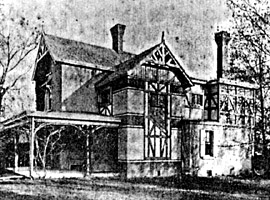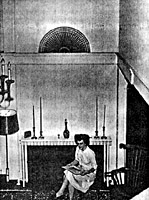





Included are five images (including pre-alteration, interiors- see three above) and the following text:
"The strong character of Germantown houses is clearly seen in those old blocks where each house has developed a personality formed by the tastes of generations of occupants. Of all the town's old houses with personality, none is more likely to catch the eye of the passerby than that of Dr. Victor C. Vaughan at 125 W. Walnut Lane.
"Now a fanciful house with a turret, windowed closets, a recurring fleur-de-lis motif, and a balcony overlooking a two-story livingroom designed as a sound chamber, it started out over a century ago as a sharp gabled, severely practical structure. Its transformation into a small castle was the work of architect George T. Pearson, who bought it in 1893 and altered it to accommodate his pipe organ.
"For this soaring instrument he ripped out a floor and ceiling, joining a first floor room and the room above it into one lofty chamber. Against one wall he placed the pipes of his organ...
"Pearson created a house to enchant the eye as well as the ear, lavishing upon it both his own skill as an architect and the work of a craftsman.
"The massive door has fluted edges, a wooden-grilled window, great metal straps ending in delicate curves, and a huge brass lock. It opens into the two-story living room, into which falls the soft light of a three-sectioned stained glass window high in the wall. A graceful stairway rises to a landing with a curved railing and a balcony whose three openings are pointed arches.
"The same pointed arch is repeated in several of the first floor doorways, and over some of the windows.
"In lighting his house Pearson gave free play to romanticism but remembered to be practical. He enclosed a sunporch, and to prevent glare he glazed the topmost row of frames with a rough surfaced light blue glass which seems to bring the sky in and keep the heat out.
"The motif of a ribboned wreath of lilies, found in the stained glass windows over the stair, is repeated in the four windows which frame a windowseat in the livingroom.
"In the front room are the building s most extraordinary windows. Two are made of small hexagonal panes of plain glass alternating with tiny square of amber glass. Two are casements at which passersby look and look again, and never guess that they are made of sea shells and lenses.
"The lower casements are of little glass circles in lead. In the upper ones the circles are the same size, but they are thick lenses set in lead, with pale yellow-green milk glass filling the spaces between them, and in the center of each casement is set a panel of sea shells.
"Through these the light filters in a spectrum of color...ivories and golden browns and hints of apricot, each shell a different shape and glowing with its own hues.
"Opposite these windows is one of the house s four working fireplaces with coal grates. Over it is a niche backed by a mirror and enclosed in a pierced wooden frame...
"The fleur-de-lis motif turns up unexpectedly in the diningroom whose dark window shade is stencilled with the repeated motif in dull gold. Entrance to this room is through narrow double doors whose upper portions are glazed with little round glass panes and stained glass garlands similar to those in the livingroom... [Deed James Taylor to Tobias Herbst, 1852, when land was vacant; deed Tobias Herbst to George Nichols, 1864, recorded stone messuage] "The time when the house was built cannot be more closely fixed, but it may have been while Ebenezer Maxwell lived next door; and strangely, the unusual ribbed ceiling of the two- story room is of the same design as that of a second floor room in the Maxwell Mansion, built in 1859."
Back to the page for this building.
|| Home || Germantown || Addresses || Texts || Maps || Key ||